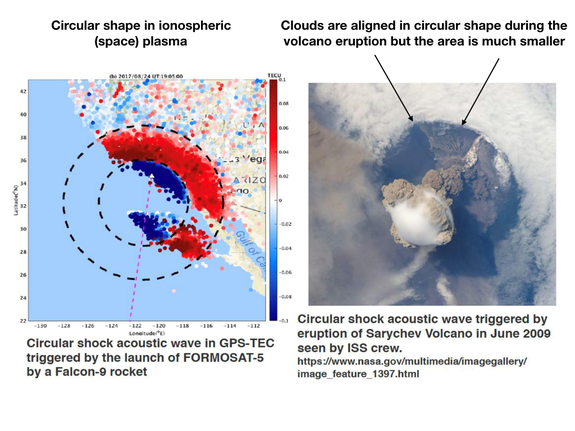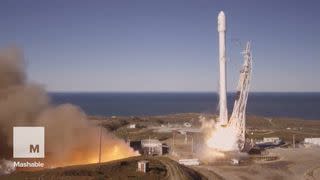A SpaceX rocket launch blew a temporary hole in Earth's upper atmosphere

On August 24, 2017, the charged particles of Earth's ionosphere were doing what they typically do: hanging out between 37 and 620 miles above the Earth's surface, basking in incoming ultraviolet radiation from the sun.
Suddenly, and rather rudely from the ionosphere's perspective, many of these particles were blown apart as a massive shockwave swept through this layer of the atmosphere.
The massive, circular shockwave — which was four times the size of the state of California — accompanied the launch of a SpaceX Falcon 9 rocket carrying a Taiwanese Earth observation satellite into orbit about 450 miles above the planet.
SEE ALSO: Thousands of SpaceX Starlink satellites could pose 'unprecedented' space junk problem
The launch followed an unusual trajectory, flying almost straight up from Vandenberg, Air Force Base in California.
Most rocket launches proceed diagonally after launch as they ascend into the upper atmosphere, therefore producing smaller shockwaves, but this one was different. The lightly-loaded rocket delivered the satellite nearly vertically to its deployment altitude.
The near-vertical nature of this launch allowed a circular shockwave to build up in the atmosphere, according to a recent study published in the journal Space Weather.

Image: AGU/Lin et al. 2018.
According to the study, led by Charles Lin, a geophysicist at the National Cheng Kung University in Taiwan, the shockwave was followed by an "ionospheric hole," which refers to sharp depletions of plasma — or charged particles — in the ionosphere.
This resulted from chemical reactions between the rocket's exhaust plumes — particularly water vapor — and the plasma. The hole was short-lived, though, with plasma levels returning to normal within about 2 hours.
In a story posted on the American Geophysical Union's website, Lin said that this was the largest such circular shockwave he has ever observed from a rocket launch, and that it was similar in shape to a 2009 volcanic eruption in Russia.
The ionospheric disturbance caused by the SpaceX launch could have had significant real-world consequences, and hints at a potential problem with so many rocket launches planned in the future as the private sector space race between SpaceX and other companies takes off.
Sharp variations in the ionosphere can distort signals from GPS satellites, causing errors of up to 1 meter, or 3.2 feet, in the case of this particular disturbance, according to the study. Everyday GPS users probably wouldn't have noticed such a distortion, but those who require more precision — such as pilots and the military — might have.
The GPS errors occur because GPS signals from satellites must pass through the ionosphere to reach Earth's surface, and the amount of plasma in that part of the atmosphere can alter the speed at which the signals travel.
WATCH: SpaceX did something amazing over the weekend

